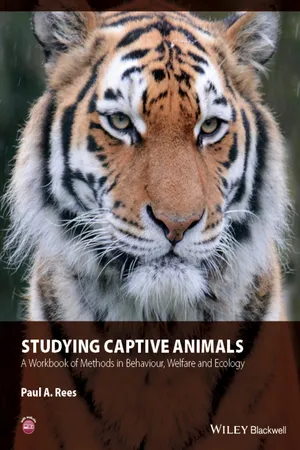
Studying Captive Animals
A Workbook of Methods in Behaviour, Welfare and Ecology
- English
- ePUB (mobile friendly)
- Available on iOS & Android
About this book
This book is a step-by-step guide to the whole process of conducting a scientific study: from designing the original project, formulating testable hypotheses, and collecting and analysing the data, to drawing conclusions from the work and writing it up as a scientific report or paper. It also illustrates how to write a formal research proposal - a crucial and often difficult element of the student project - and how to deal with the ethical review process.
Sample data collection sheets are provided and the analysis and presentation of data are worked through in diagrammatic form. In addition, exercises are included that enable the reader to practice analysing different types of data and advice is provided on the selection of appropriate statistical tests. The text describes the different types of student projects that may be undertaken in the field, and explains where secondary data may be found for zoos.
This is an insightful resource, particularly for those studying and working with zoo and farm animals. It is essential reading for students studying zoo biology and animal management; it is also suitable for students on courses in animal behaviour, animal welfare, zoology, biology, psychology, animal science, animal production, animal ecology, conservation biology, and veterinary science. This book is primarily intended for undergraduates but will also be of value to postgraduate students who have not previously engaged in field studies. Professionals working in institutions that are members of the World Association of Zoos and Aquariums, the European Association of Zoos and Aquaria and other regional and national zoo organisations will benefit from access to this practical guide.
Frequently asked questions
- Essential is ideal for learners and professionals who enjoy exploring a wide range of subjects. Access the Essential Library with 800,000+ trusted titles and best-sellers across business, personal growth, and the humanities. Includes unlimited reading time and Standard Read Aloud voice.
- Complete: Perfect for advanced learners and researchers needing full, unrestricted access. Unlock 1.4M+ books across hundreds of subjects, including academic and specialized titles. The Complete Plan also includes advanced features like Premium Read Aloud and Research Assistant.
Please note we cannot support devices running on iOS 13 and Android 7 or earlier. Learn more about using the app.
Information
PART 1
Introduction

CHAPTER 1
Studies of Behaviour, Welfare and Ecology in Captive Animals
To begin at the beginning
Dylan Thomas (1954)

1.1 What Are Captive Animals?
1.1.1 Introduction
1.1.2 A Short and Incomplete History of Captive Animal Studies
The male camel declines intercourse with its mother; if his keeper tries compulsion, he evinces disinclination. On one occasion, when intercourse was being declined by the young male, the keeper covered over the mother and put the young male to her; but, when after the intercourse the wrapping had been removed, though the operation was completed and could not be revoked, still by and by he bit his keeper to death.
Of all wild animals the most easily tamed and the gentlest is the elephant. It can be taught a number of tricks, the drift and meaning of which it understands; as, for instance, it can be taught to kneel in presence of the king. It is very sensitive and possessed of an intelligence superior to that of other animals.

…wantonly and cruelly beat, abuse or ill treat any Horse, Mare, Gelding, Mule, Ass, Ox, Cow, Heifer, Steer, Sheep or other Cattle…
Table of contents
- Cover
- Title page
- Table of Contents
- Preface
- Acknowledgements
- About the Companion Website
- PART 1: Introduction
- PART 2: Measuring Animal Behaviour and Welfare
- PART 3: Measuring Ecology
- PART 4: Statistics and Report Writing
- Appendix
- References
- Further Reading
- Index
- End User License Agreement